Endurance, devotion to an ideal, and sublime courage in the face of death are inseparable from Arctic and Antarctic exploration. These qualities were never seen to better advantage than with Shackleton’s 1907-1909 remarkable expedition to the South Pole
EPICS OF EXPLORATION - 1
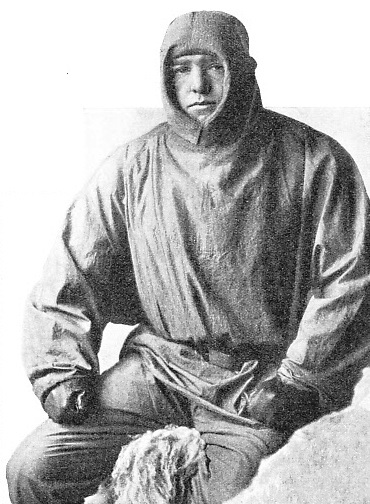 LATE in the afternoon of New Year’s Day, 1908, a tiny ship crept slowly out of Lyttelton Harbour, New Zealand, picked up a tow-line from the steamer Koonya, signalled a final goodbye to several thousand spect-ators, and was soon swallowed up in the gathering darkness. She was E. H. Shackleton’s Nimrod, and her course lay towards the unknown South Pole.
LATE in the afternoon of New Year’s Day, 1908, a tiny ship crept slowly out of Lyttelton Harbour, New Zealand, picked up a tow-line from the steamer Koonya, signalled a final goodbye to several thousand spect-ators, and was soon swallowed up in the gathering darkness. She was E. H. Shackleton’s Nimrod, and her course lay towards the unknown South Pole.
Ernest Henry Shackleton (1874-1922) had already seen Antarctic service in Capt. R. F. Scott’s Discovery expedition in 1901, and had shared the honour of putting the “Farthest South” record up to 82° 17' S. Invalided home with scurvy, he had spent four years planning a new venture, with himself as leader, which should beat Scott’s record and, if possible, reach the South Pole itself.
SIR ERNEST SHACKLETON commanded the 1907-1909 British Antarctic Expedition which ascended Mount Erebus, reached the South Magnetic Pole for the first time, and attained a point approximately 100 miles from the South Pole itself.
Although poor and almost unknown, his personality and his enthusiasm overcame all obstacles. He believed in himself and made financiers believe in him. In February, 1907, he published his plans. He proposed to winter with a small party in King Edward VII Land, sending his ship back to New Zealand. In the Antarctic summer of 1908-9 his “southern party” would strike southward over the Ross Barrier and make for the Pole, while another small party would try to reach the South Magnetic Pole, known to be situated somewhere in Victoria Land. Such was his simple, quietly-worded programme; only the few who knew something of Antarctic exploration could realize the endurance and struggle which inevitably awaited those undertaking the ordeal.
Finance determined the choice of a ship. Shackleton bought the Nimrod, which had the disadvantages of being forty years old, small, and incapable of a speed of much over six knots. Her chief virtue lay in the solidity of her build. Throughout a varied career she had proved herself able to stand up to rough treatment; thus she seemed well suited to Shackleton’s purpose.
Her commander, however, was not impressed by his first view of her; in The Heart of the Antarctic, his personal account of the expedition, he wrote:
I must confess that I was disappointed when I first examined the little ship, to which I was about to commit the hopes and aspirations of many years. She was very dilapidated and smelt strongly of seal-oil, and an inspection in dock showed that she required caulking and that her masts would have to be renewed. She was rigged only as a schooner and her masts were decayed, and I wanted to be able to sail her in the event of the engine breaking down or the supply of coal running short. There was only a few weeks to elapse before the date fixed for our departure, and it was obvious that we would have to push the work ahead very quickly if she was to be ready in time. I had not then become acquainted with the many good qualities of the Nimrod, and my first impression hardly did justice to the plucky old ship.
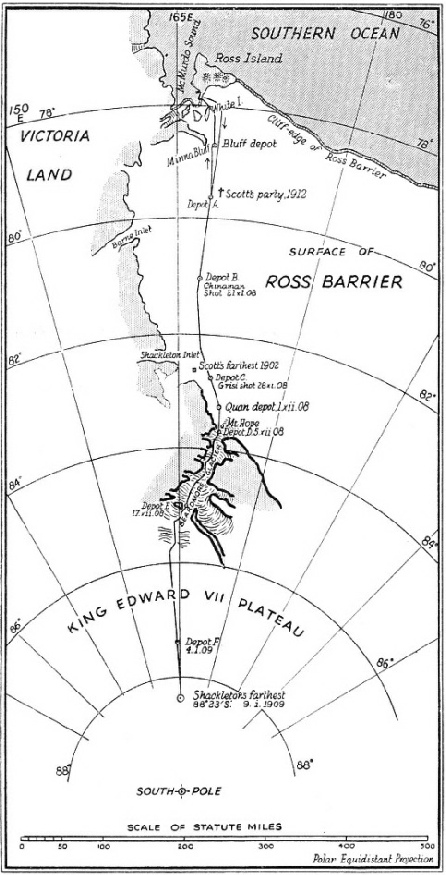 The Nimrod was passed to the ship repairers, whose efficient work on her convinced Shackleton that the vessel would not discredit his expedition.
The Nimrod was passed to the ship repairers, whose efficient work on her convinced Shackleton that the vessel would not discredit his expedition.
The ship was towed southward for 1500 miles to save her scanty coal supply. Favoured by fortune, she then crept onward through a berg-strewn sea, at her maximum of six knots, without meeting the belt of pack-ice which normally guards the Antarctic continent. But King Edward VII Land proved to be ice-fringed and inaccessible, and Shackleton was compelled to steer for Ross Island, which the Discovery had made her base. Here he and his fourteen men built their hut and wintered.
SHACKLETON’S ROUTE to the South Pole is shown on this map. New land discovered by the 1907-1909 Expedition is outlined in black.
On October 29, 1908, the Polar party left winter quarters and began their long journey into the unknown.
Shackleton had selected three companions: J. B. Adams, Dr. E. S. Marshall, and Frank Wild, who had been with him in the Discovery. All were young men; Shackleton thirty-four, Wild a year older, and the others twenty-eight and twenty-nine respectively. The leader had planned to reach the South Pole - some 750 miles distant - in the early days of January, 1909; and he left instructions that if none of them had returned by February 25, the Nimrod, back by then from New Zealand, should leave a party behind her who would winter at the hut and go southward the following spring to search for the bodies and journals of the party.
Shackleton had helped to haul sledges for hundreds of miles over the Barrier, and knew the terrific labour entailed. A better method was badly needed, and the obvious plan, as Amundsen showed later, was to take an abundance of sledge-dogs. Shackleton had always been opposed to them, and, although he took a few dogs, he pinned his hopes mainly on another, and quite original, substitute for man-power. Fifteen ponies had been shipped from Manchuria, hardy little beasts with shaggy white coats, sure-footed and accustomed to hauling heavy loads in a very low temperature. Of these, four remained - “Quan”, “Chinaman”, “Grisi” and “Socks” - an each was harnessed to a light sledge with a carefully adjusted load of about 600 lb. The party had full rations for ninety-one days and three weeks’ pony fodder; while, to have any chance of reaching the Pole they must make in all weathers, and not allowing for contingencies, an average of nineteen miles a day - more than three times the daily distance which Scott’s party had accomplished in 1902.
A supporting party of five men hauled an additional sledge-load as far as White Island, and helped to see the Polar party through some of their initial difficulties. The start had not been promising. Before the sledges had even reached the Barrier - while they were still on the ice fringing Ross Island - Socks went lame; and a little later Adams narrowly escaped having his knee-cap shattered by a vicious kick from Grisi, which cut his leg to the bone. Luckily, neither he nor Socks was permanently lamed; but Shackleton’s hopes of getting a flying start on the way southward were dashed by a combination of bad surface with bad weather.
Normally, the surface of the Ross Barrier, which is a gigantic ice-sheet with a seaward face some 450 miles long and receding southward for hundreds of miles, is moderately smooth for sledging; but, where its surface is broken by solid land protruding through it (as at White Island), the ice-pressure produces an irregular surface full of crevasses - huge vertical clefts covered with a thin crust of snow which might bear a man’s weight but which might collapse under the pony he led. In the afternoon of November 5 Marshall and Grisi all but crashed down into a crevasse which suddenly opened below them. Its floor was so far below as to be out of sight.
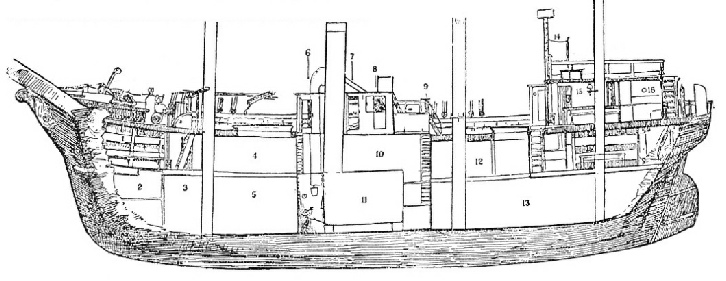
THE INTERIOR OF THE NIMROD. 1. Fore-castle. 2. Stores. 3. Chain Locker. 4. Fore Hold. 5. Lower Hold. 6. Stokehold 7. Carpenter’s Shop. 8. Cook's Galley. 9. Engine-room. 10. Engine-room. 11. Boiler. 12. After Hold. 13. Lower Hold. 14. After Bridge. 15. Officers’ Quarters. 16. Captain’s Quarters.
Later that day a blizzard began to blow, with thick, drifting snow. That evening, and all next day, the party huddled in their tiny canvas tents, only quitting their sleeping-bags to feed the ponies. For these no shelter was possible and they had to be tethered in the snow; but even the worst weather seemed hardly to affect them. Still, they had to be fully fed; while the Polar party, chafing at this enforced delay, had already resolved to cut down their own meagre rations, and so spin their 91 days out to 110. Hence-forward, except on one or two red-letter days, they were to be perpetually and ravenously hungry.
On November 7, the blizzard having blown itself out, the Polar party got under way. The supporting party stood and cheered them, watching the four men and their four ponies plodding doggedly onward into the white distance. The ponies, in any event, were doomed; their fodder would not take them halfway to the Pole, and Shackleton carried a revolver to end their lives humanely when the need arose. Would the men fare better? They realized the chances of failure.
For the first few days after parting company with the supporting party the track led through a maze of crevasses, Adams and Chinaman being almost lost in the last of these. Then, as they drew away from White Island, the surface improved, and one or two strange incidents broke the monotonous routine of their daily marches. One evening the ice under them vibrated with the con-cussion of what seemed to be heavy guns firing far to the eastward. Startled, they concluded that the noise was that of a berg “calving” from the face of the Barrier a good fifty miles away. Twice, on successive days, they crossed recent tracks of Adelie penguins, birds incapable of flight, apparently coming from Victoria Land (fifty miles west of them), and heading due eastward over the Barrier.
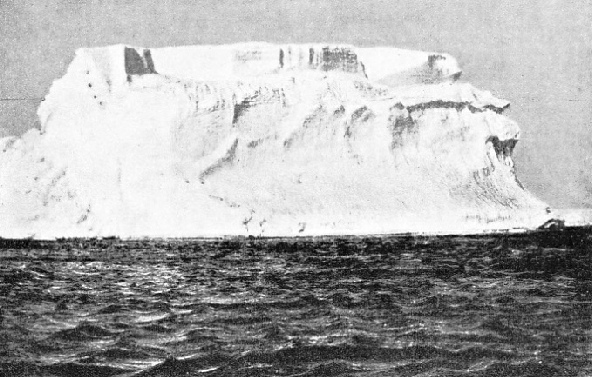
THE FIRST SENTINEL of the frozen south. This tabular berg was sighted by Shackleton fourteen days after he had left New Zealand. From this point the Nimrod had to travel through a berg-strewn sea at her maximum speed of six knots. One of the bergs encountered was over five miles in length, although not more than forty feet high.
The party were making good some twelve to fifteen miles southward daily, but already the strain was beginning to tell upon men and ponies. Wild and Shackleton, who were well accustomed to Antarctic sledging, suffered badly from snow-blindness, as did the animals. The way of avoiding this was to wear goggles all the time; but in moderate temperatures these soon became misty with perspiration, and needed constant wiping. On November 12 Shackleton's eyes were so bad that he could scarcely see; although covered by goggles, water streamed from them continually, and froze on his beard.
Three days later they reached a depot of pony-fodder and oil which, in the spring, had been laid out for them in 79° 36' S, about a hundred miles along the way to the Pole. Here they left all dispensable gear and all food saved from daily rations. They christened the spot “Depot A”. Three years later Scott and his men were to make their last camp, and find their graves, a few miles eastward of it.
When the party left Depot A weather and surface improved, and the company pushed on southward, intent upon advancing their food supplies as far as possible before the ponies died. Their daily mileage increased to 16, and then 17, but by now the pony, Chinaman, was so stiff in the knees that he had almost to be dragged along. Had the men hauled on the drag-ropes to lighten the work, the ponies would have refused to haul. Strain and exposure were telling on the beasts, and their end could not be far away.
Chinaman was the first to go. On November 21 the party camped just south of 81° S, and he was then led behind a snow-mound thrown up to leeward (so that no smell of blood could come down wind) and shot, painlessly. Meat of any kind was too precious to waste, so the rapidly freezing carcass was immediately cut up. Part was loaded, and the rest buried as a depot (B) for future use, Chinaman’s discarded sledge and a black flag being left to mark the spot. To facilitate the picking up of these depots on the return journey a snow-mound was thrown up at each camp. They proved to be well worth the labour.
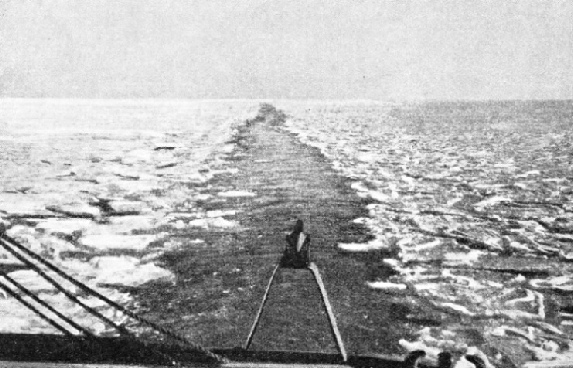
PANCAKE ICE in the wake of the Nimrod. Before she could approach the Ross Sea she had to work her way through a floating belt of ice. So that as much coal as possible could be saved, it was arranged that she should be towed for the first 1,500 miles of the outward trip. The day after the towing ship had cast off and the Nimrod was left to her own resources she encountered this belt of ice guarding the approach to the Ross Sea.
The party pushed on next morning with three ponies, each dragging 500 lb, and the day was made memorable by the appearance of new land to the southward - mountains, a long way south of Scott’s farthest, on which no human eye had rested before. As they advanced, each day brought some fresh peak into sight, and, lower down, a coastline, abutting on the Barrier, could gradually be made out. This was a continuation of Victoria Land. It extended south-eastward, across their track, and evidently they must soon leave the Barrier surface and, if possible, make their way inland. Here they had Scott’s experiences to guide them. In 1903 he and a small party had made a sledge journey due west from Ross Island. They had discovered several huge glaciers, creeping down the valleys, dividing the mountains of Victoria Land and merging into the Barrier; and up one of these glaciers they had made their way to the interior, a large glaciated plateau, windswept and barren of all life, moderately smooth-surfaced and apparently extending for hundreds of miles in all directions. Such was the region which Shackleton and his men expected to find - and did find.
There were still many miles of the Barrier between them and their new land. The ponies were pulling well, but Adams was almost sleepless with incessant toothache, and Wild showed passing symptoms of what proved later to be dysentery. But the weather was fine, and the day temperatures, which had long been below zero, rose to as much as 17° Fahr. By November 26 prospects were a little brighter. Adams’ tooth was out (and a new one growing in its place!); Wild was better; and they had camped in 82° 18½’ S, having beaten Scott’s “Farthest South” and reached it much earlier in the sledging-season. They celebrated the event with a four-ounce bottle of Curasao (given by a friend expressly for such an occasion) and, rarest luxury, a smoke.
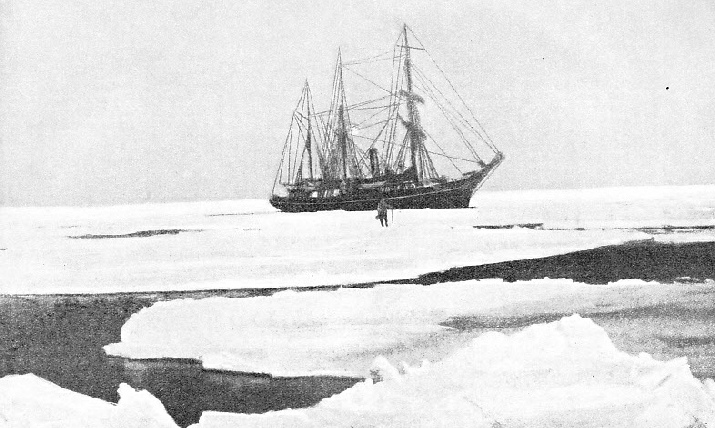
PUSHING HER WAY through open pack ice, the Nimrod is shown making for King Edward VII Land. At one period the ship encountered close pack ice set with huge icebergs, and Shackleton found that the whole of the northern pack and bergs were drifting towards him. This meant that detached cliffs were moving in from seaward, slowly but inevitably, and it was only a matter of time before the two masses would meet and crush his comparatively small craft between them.
Next day it became obvious that Grisi, snow-blind and off his feed, was nearing his end. Thus he was shot after a camp was made the following evening. As before, a depot was made (C) and part of the meat left, with Grisi’s sledge and a flag to mark it.
The surface now became bad - soft snow in which the pair of ponies sank to their bellies, while the men’s united efforts could scarcely budge the sledges. Sastrugi (snow-ridges), running east and west, also appeared in numbers, and added greatly to the labour, while the sun’s combined heat and glare necessitated eyeshades for the ponies and compelled the men to haul, stripped to their shirts. Quan - Shackleton’s special pony - was nearly played out, and, after camping on December 1, he was shot. He had pulled his weight to the end, and was a general favourite, despite his annoying tricks. He had a habit of chewing odds and ends of clothing in preference to his proper food; and at the start of the journey he had broken loose during the night and devoured an incredible quantity of the carefully rationed fodder.
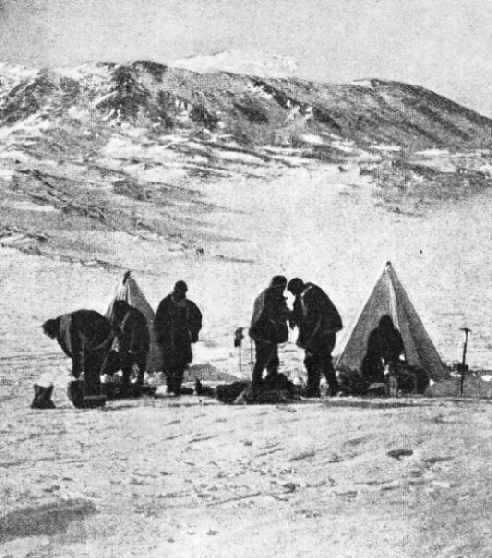
THE EXPEDITION TO MOUNT EREBUS. A party of Shackleton’s men ascended this ice mountain, which stands at the gate of the Great Ice Barrier and which rises from sea-level to an altitude of over 13,000 feet. The white mass at the top of the mountain is smoke or steam from an active volcanic cone. This picture shows the expedition camped 7,000 feet up Mount Erebus. It was discovered in 1841 by one of the greatest of Antarctic explorers, Sir James Ross, and named after his
ship, HMS Erebus.
The party had advanced over three hundred miles southward in a month, and were not far from half-way to the Pole. But the worst, as they well knew, lay ahead of them, a test of courage and stamina such as few men had voluntarily faced. One pony, Socks, was left, two sledges, and a scanty supply of food - which was little more than enough to ensure their return if they faced about at once, content merely with breaking Scott’s record. Far ahead of them they could make out the foot of a large glacier, running inland south-westward between two ranges of mountains. This was their only chance of a route to the Pole. If possible, they must climb it, first crossing the pressure-ridges, and their inevitable crevasses which guarded its approaches, and then, with what little food they had (and no chance of more), strike southward over the inland plateau.
So these four grim, half-starved, indomitable men planned, as they huddled in their sleeping-bags, while outside the two little tents Socks whinnied dolefully for his companions. It needed courage to make plans in such circumstances.
Two days of hard pulling, the four men hauling on one sledge and Socks following with the other, saw them at the foot of the great glacier, which Shackleton named Beardmore, after one of the expedition’s backers. Right in its jaws rose a 3,000-ft hill (Mount Hope), offering a magnificent viewpoint.
Snow-Blindness
The party, having left Socks tethered in camp with food for the day, roped up and attacked the climb. Shackleton, in his eagerness, led them without goggles, and paid the inevitable penalty of a violent attack of snow-blindness. The view from the summit showed conclusively that the only way South led up the Beardmore Glacier, a climb of unknown length over heavily crevassed glacier-ice with laden sledges and no proper climbing equipment.
On the morning of December 5, Shackleton was almost blind, and Marshall and Adams reconnoitred the glacier-foot for a practicable route. While doing so, they were surprised by the appearance of a brown bird of unknown species, which swooped just clear of their heads and disappeared to the southward. After a hurried meal, the sledges were loaded, and the supreme test of the final climb up the glacier began. It took nearly three weeks of appalling labour, of hauling and rehauling the sledges, one at a time in relays, over snow-bridged crevasses and pits of unknown depth.
Soon Socks was no longer with them. On the second day of the climb Shackleton, still half blind, Marshall and Adams, who were hauling the leading sledge, heard a shout of “Help!” from Wild, who was following with Socks. Swinging round, they saw the pony-sledge tipped on end, its bow down a crevasse which had opened across their own tracks. Wild, half-way over the edge, was clinging to the sledge, but there was no sign of poor Socks. After hauling Wild and the damaged sledge to safety, they lay down and peered into the chasm, but all was darkness and silence. The pony’s weight had been too much for the snow-crust, and he had gone instantly to his death. Mercifully, the harness had broken, and saved the sledge; with that would have gone all chance of reaching the Pole and all but the barest possibility of reaching the winter quarters again.
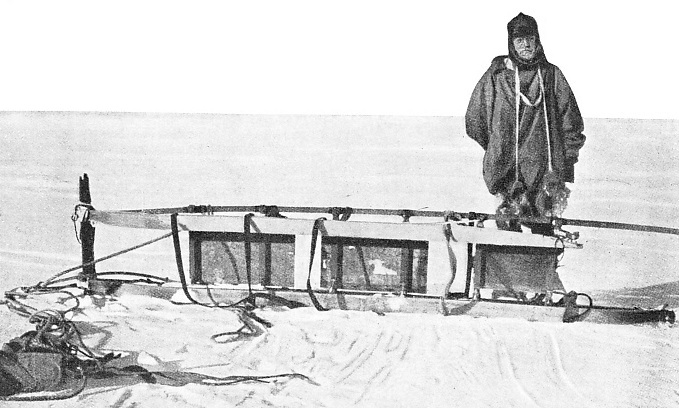
A BROKEN SLEDGE, when Shackleton and his party were fewer than 200 miles from the South Pole, was an additional burden to men already weak through semi-starvation, illness and exposure. The ponies were dead and the four men who made the trip farthest south - Shackleton, Adams, Marshall and Wild - dragged their sledges slowly and patiently through the snow and ice towards their goal.
Alone, and hundreds of miles from help, they dragged their sledges patiently and steadily upwards day by day. In spite of fatigue, the four continued the sketch-survey of their new land, took theodolite observations for position, measured heights by hypsometer, and even secured geological specimens, including samples of outcropping coal. Apart from such work, their minds chiefly centred on two things: the chance of their reaching the Pole and the expectation of one day appeasing the hunger which worried them incessantly. At night, when sleep did come, they dreamed of food; while hauling, they talked of little else. Christmas Day, 1908, stood out in their calendar. They camped in 86° S, near the head of the Beardmore glacier, and fed full on pemmican “hoosh”, a tiny plum pudding, cocoa, cigars and a spoonful of creme de menthe. It was their last full meal for many a day.
The weary climb was almost over. They had fought their way up the glacier for well over 100 miles, and were almost 10,000 feet above sea-level. Two days later they cleared the head of the Beardmore, and were on the plateau at last. But the Pole was still more than 250 miles away, and the going bitterly heavy. The surface was covered with soft snow; rarefied air and a temperature of minus 16° Fahr. made breathing so difficult that after each hour’s pulling they were glad to throw themselves on their backs for a “breather”.
On New Year’s Day, 1909, they camped in 87° 6½' S, “holding both North and South records”. [So far as the party then knew, the “farthest north” claimed by any explorer was Peary’s 87° 6' N, in 1906.] And Shackleton, suffering agonies of mountain-sickness in the form of a chronic and maddening headache, forced himself to take a calm and dispassionate view of their position and chances.
The food shortage was acute - they had three weeks’ pemmican and two weeks’ biscuit to take them 500 miles. Every step of their advance on the plateau had been uphill, through soft snow, with frequent head-winds blowing the drift in their faces, and in a temperature which never rose to zero. Frostbite and mountain-sickness had attacked the party, who were weakening rapidly, and three had temperatures so far subnormal that the clinical thermometer would not record them. Their footgear was worn to rags by that nightmare climb up the Beardmore. To go forward at all entailed the gravest risk; to push on to the Pole meant certain death.
Unselfish Leadership
Undoubtedly they could reach it, if reaching it were all, but they could never win their way back to the nearest depot. To have a chance of safety, they must turn about while still short of the Pole. It was bitter to come so near and fail at the last, but they could not fight a losing battle indefinitely against the forces of Nature. That in such circumstances Shackleton could face the facts squarely, and put his men’s safety before even his life’s ambition, emphasizes his real greatness as a leader.
None the less, the four intended to get as near the Pole as possible before turning, and on January 4 they cheerfully took the enormous risk of leaving a depot on the windswept plateau itself, where only their tracks, which the snowfall might obliterate, could guide them back. Plodding painfully through the heavy snow, cutting their feet on sharp Sastrugi, battling with continuous head-winds, and sheltering from 50° of frost at night in a single tent, they made their last outward camp, in 88° 7' S. on January 6. They planned to push southward next day with the flag Queen Alexandra had given them, and to hoist it at the turning-point; but two days of furious blizzard kept them huddled in their bags, with the wind, and even the snowdrift, cutting through their thin tent in eighty-miles-an-hour gusts.
Soon after midnight on January 8-9 the wind eased down, and at 4 am they started South for the last time, free for once of the dragging sledge. Loping onwards for five hours at a half-run over the frozen snow, they halted at 9 am to take sights. They were in 88° 23' S, less than 100 geographical miles from the Pole. Their bolt was shot at last.
Two Union Jacks, one of them the Queen’s, were hoisted, and Shackleton took formal possession of the plateau for his country. That it included the Pole was almost certain, but powerful glasses revealed nothing to the southward but the endless, dead-white plain. After they had taken a photograph they struck the flags and set their faces northward.
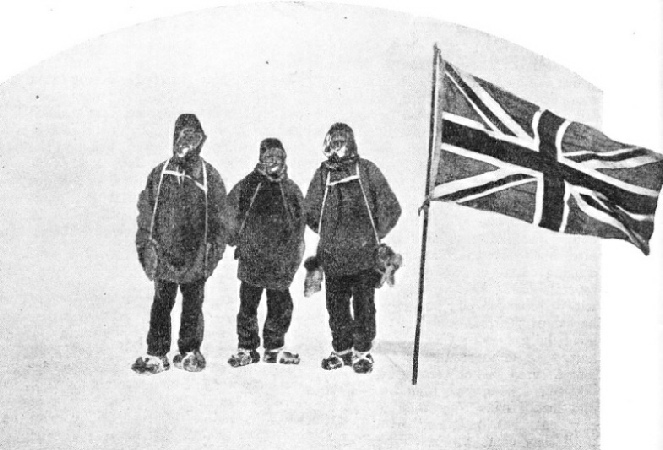
A GALLANT EXPLOIT. On January 9, 1909, the 100 geographical miles from the Pole. Two Union Jacks were hoisted, one of them presented to the expedition by Queen Alexandra. Thus Shackleton took possession of the Polar plateau for his country. After a photograph had been taken, flags were struck and the homeward journey was begun.
Although falling short of the Pole, they had outdistanced their predecessors more completely than anyone had done before or could do again. To achieve this they had staked and all but lost their lives. As the event showed, death was very near them along every mile of the weary homeward marches, and only a combination of extraordinary endurance with good fortune saved them from the fate which befell Scott’s Polar party three years later.
Guided by their outward tracks, which the blizzard, curiously, had made more distinct, they picked up the depot left on the plateau, hoisted an extempore sail on the sledge, and pushed northward, helped by the downward slope and a following wind, at twenty miles a day.
The temperature continued to be low, and at night the cold made sleep difficult. Shackleton suffered from frostbite, his heels and toes cracking and causing him considerable pain for several days. Their hunger increased with reduced rations; but despite these hardships they continued to keep up a good daily speed. One day during a halt, they discovered that the sledge meter, used in calculating distances between depots, had been broken off and lost. Thus they were forced to rely on their judgment of distance until they came within sight of land.
This they did on the following day, after not having seen any land for close on three weeks of monotonous travelling. On January 17 they said good-bye, without regret, to the vast, desolate plateau and came down the Beardmore Glacier at great speed, covering twenty-six miles on January 18 and twenty-nine on the day following. In the evening of January 27, having eaten their last scraps of food more than twenty-four hours earlier, they reached the depot they had left at the foot of the Beardmore, and were back on the Barrier with a bare six days’ food available. It had been touch and go whether they would even get that far, since Adams and Wild had both fallen in harness, from sheer weakness, while on the march.
Saved by a Mirage
The food in the depot was mainly horse-flesh, and Wild, who had developed dysentery, could not eat it. A few biscuits remained, of which each man received one a day, and Shackleton, starving himself, gave his to Wild. Neither Adams nor Marshall knew of the gift, and it was revealed by Wild only after Shackleton’s death. But he noted in his diary:
S. privately forced on me his one breakfast biscuit, and would have given me another to-night had I allowed him. I do not suppose that anyone else in the world can thoroughly realize how much generosity and sympathy was shown by this; I do, and by God I shall never forget it.
Once the Barrier surface had been reached the worst of the marching was over, but now a fresh danger threatened. Acute dysentery, probably caused by the horse-meat, attacked the whole party. Throughout one terrible day (February 4) they lay encamped, totally unfit to move farther. Marshall, himself one of the worst affected, did what he could with the help of their tiny stock of medicines, and next day the march was resumed. Luckily, the surface was better and the weather fine. They struggled on, managing to make the food obtained from one depot just carry them to the next.
Two birthdays were celebrated: Ray’s (Shackleton’s daughter) with two extra knobs of sugar in their cocoa; on his own birthday Shackleton was presented with a cigarette, which, although made of pipe tobacco and coarse paper, seemed to him to be the height of luxury.
The surface became better for travelling, and the health of the party generally improved, but hunger was making them extremely weak and was a great anxiety to their leader. Their rations for a time consisted of one pannikin of horse-meat each meal and six biscuits a day, but later these were reduced to half a pannikin of horse-meat a meal and four biscuits a day. Hunger was always with them: throughout the day it was the chief subject of their thoughts and talk; at night it brought tantalizing dreams.
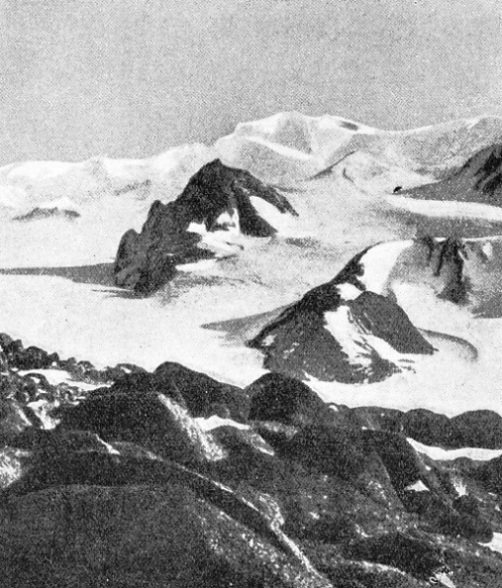
SHACKLETON AND HIS PARTY were the first to see these mountains, which they did after having passed Scott’s Farthest South. Climbs over heavily-crevassed glacier-ice had to be made without mountaineering equipment and with the handicap of heavily-laden sledges. The route to the Pole was barred by a great glacier slope, followed by a desolate, blizzard-swept plateau.
On February 20 they reached the last depot (A), which they had laid themselves. Everything turned on their picking up the Bluff Depot, between them and Ross Island, which was to have been laid out during their absence. If they failed to find it, or if by any accident it had not been laid out, they were doomed men, as their present food supplies would not carry them to Ross Island.
On February 22 they struck the fairly recent tracks of a party of four men with dogs, a reassuring sight, since these must have been made by the party laying the Bluff Depot. Next day they picked up the depot itself by a miracle. It lay far to the right of their line of march, and they would have passed without sighting it (its flag was below their horizon), if an accidental mirage had not brought the flag into sight long enough for them to note its bearing. Here they found food in plenty, and a note to say that the Nimrod had returned, and was lying in McMurdo Sound.
Even then the strain of their race against time was lessened, but not removed. Marshall, who struggled along uncomplainingly, was obviously ill with renewed dysentery. After two more marches Shackleton left him in camp, with Adams to look after him, and pushed on with Wild. They reached the old Discovery hut at Ross Island on the night of February 28, but found only a note saying that all the other parties were on board the ship, which would wait for them in McMurdo Sound until February 26 - two days earlier. It looked as though death had won on the post. If the ship were gone (she had obviously not landed the search-party) and they had to face a second Antarctic winter, their plight was almost hopeless.
But the Nimrod had not gone. Capt. C. P. Evans (formerly of Koonya), who now commanded her, had nearly given the southern party up for lost; but he had been persuaded to hold on until the last moment, and was still in the Sound. Next morning Shackleton’s signals were seen, he and Wild having set the old “magnetic hut” on fire, and also used a heliograph; by 11 am both were safely on board. Shackleton stayed only long enough to organize, land and lead a relief-party to bring Adams and Marshall in. He learned, at the same time, that his northern party, consisting of Professor David, Mawson and Mackay, had hoisted the flag at the South Magnetic Pole on January 16, 1909, and had returned safely. By March 4 the Nimrod was making the best of her way to New Zealand under steam and sail, with every man of the expedition safe on board.
They received a magnificent welcome at Lyttelton, and the summary of his results which Shackleton cabled for publication brought him permanently into the world’s news. Once back in London, congratulations and gold medals were showered on him, and his great achievement found official recognition in a knighthood and a grant of £20,000 to pay off the outstanding debt on the expedition.
He was never to touch quite the same heights again. But his place among great Polar explorers is secure; and his chief exploit, when he so bravely showed the way to the South Pole and so narrowly failed to reach it, will long be remembered. Admittedly, such feats are of limited scientific value; but a nation which can breed the men who accomplish them need not fear the future.
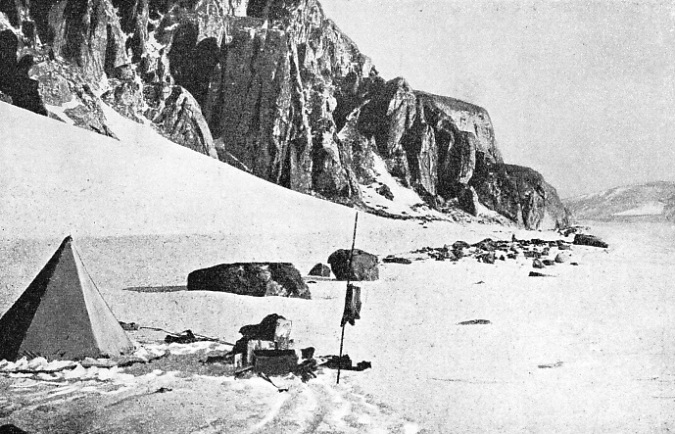
THE SHADOW OF DEATH which stalked the four intrepid explorers on their return journey to the Nimrod was kept at bay only by the food depots left on the outward journey. Stores were buried in the snow and a flag or piece of cloth was tied to a post to indicate the position. Food in the depots consisted largely of horse-flesh, a diet that did little to alleviate the adventurers’ hardships.
You can read more on “The Franklin Mystery”, “Scott’s Gallant Failure”, “South with Shackleton” on this website.



 LATE in the afternoon of New Year’s Day, 1908, a tiny ship crept slowly out of Lyttelton Harbour, New Zealand, picked up a tow-
LATE in the afternoon of New Year’s Day, 1908, a tiny ship crept slowly out of Lyttelton Harbour, New Zealand, picked up a tow- The Nimrod was passed to the ship repairers, whose efficient work on her convinced Shackleton that the vessel would not discredit his expedition.
The Nimrod was passed to the ship repairers, whose efficient work on her convinced Shackleton that the vessel would not discredit his expedition.







